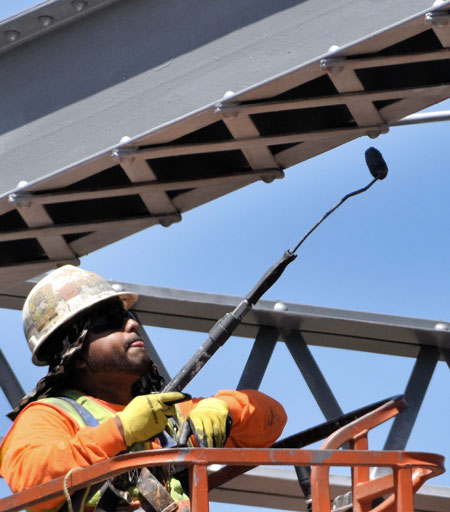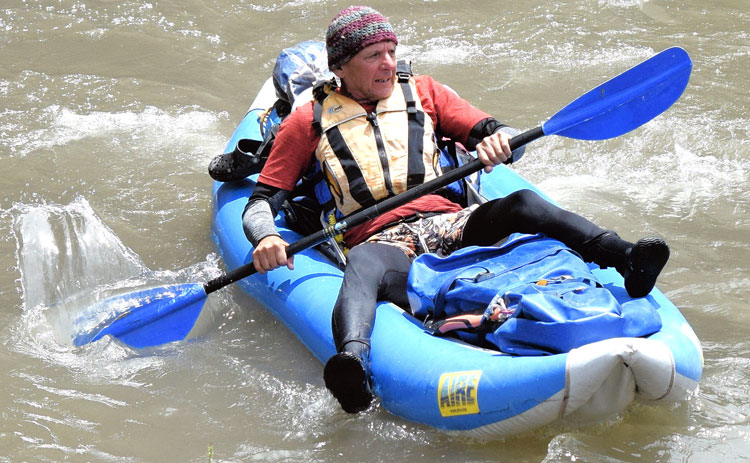Raymundo Frasquillo Photo/Gila Herald: An employee of sub-contractor Murphy Industrial Coatings uses a hydraulic lift to start a one-to-one ratio of primer and epoxy coverage. The Zorrilla Bridge maintenance project was begun in April and is expected to be completed in September.
By Raymundo Frasquillo
CLIFTON – Nearly two months into the Zorrilla Bridge repair project, Phoenix-based Banicki Construction is able to start addressing the deck replacement portion. The sidewalks leading onto the bridge and half the roadway asphalt covering and top layer of 3x4x8 ¼ wooden bricks were removed by the end of May, the second month.
Initial work during the opening month, the first week of April included building a hanging structure to work underneath the bridge.
“It was like building an erector set,” project foreman Matt Dey said. “We started at one end and it got harder as we went because we had to carry material farther to complete the other end.”
The platform allowed workers to remain out of the water and prevent contaminants from falling in the river.

Sub-contractor Murphy Industrial Coatings encased the bridge in plastic sheets and vinyl tarps, used high-pressure water and hand tools to remove leaded paint, and coat a majority of the structure with a one-to-one ratio of gray-colored primer and epoxy with hand rollers. Eighty 5-gallon containers were at their disposal. The four-man crew got an unplanned early start to a four-day weekend May 22 when it ran out of paint. They had another 40 same size containers on site after the Memorial Day holiday.
Contractors are working 10-hour days, four days a week, usually Monday through Thursday, unless they get behind. The recent holiday prompted working Tuesday through Friday for the last week of May. The projected completion is September.
A brief delay followed area high winds of a few weeks ago, necessitating taking time to reattach protective plastic sheets.
Zorrilla Bridge

The 210-foot long Zorrilla Bridge, formerly known as the Riley Street Bridge because of its’ proximity to the 1983 flood-ravaged Riley’s Drug Store and Soda Fountain, is one of three bridges spanning the San Francisco River as it winds through Clifton. It is the granddaddy of the three, over 100 years old and still standing. It lies in the town’s central area and accesses the section known as Eastside. The bridge closure necessitates access through Park Avenue from Highway 191 in South Clifton. Detour signs are in place.
Clifton’s share of the $2.7 million project cost is about $336,000 with the rest covered by an off-main-system transportation grant via ADOT.
Polly Rosenbaum Bridge

Upriver from the Zorrilla Bridge is the “road to nowhere bridge” in North Clifton, accessing the now uninhabited area known as Paterson’s Addition along with several upstream ranches and recreation areas. Three separate improved restroom facilities are included along the road.
The bridge is named for the late 45-year state legislator E.C. “Polly” Rosenbaum who passed at age 104 in 2003. She was instrumental in obtaining funding for its construction. It replaced the structure removed by the October 1983 Flood and was completed in 1987. It is nearly 33 years old.
Although projected as a six-month project, the Paterson’s Addition bridge replacement project was completed in less than five months. Utah-based Nile Chapman Construction Company started on Feb. 2 and ended on June 19. The on-site plaque states a July 21 dedication, but, it was delayed until Sept. 30 because of the special session called by the governor at the time.
Over 70 pylons were driven into the river bed and rock-filled heavy-gauge wire baskets stacked for embankment protection from erosion. The 233-foot roadway bridge has two lanes.
The total cost was $1,030,646.15, largely paid by the Federal Emergency Management Agency. Aside from initial clean-up, it was the first major flood recovery project completed since the flood.
ADOT No. 2904

The youngest bridge, Arizona Department of Transportation structure No. 2904, is downriver from the Zorrilla Bridge in South Clifton. Although it sports a date of 2011, the replacement bridge project began in September 2010 and was completed in July 2012.
Phoenix-based C.S. Construction Inc., along with sub-contractors erected the bridge on Coronado Boulevard and current U.S. Highway 191. It is an ‘H-Span’ closed continuous slab bridge, having a 316-foot, 7-inch long deck with a 66-foot wide, two-foot thick floor 22 feet below plus four-foot cut-off walls, seven 15-inch thick columns, and two abutment walls. Two 15-foot, two-foot deep approaches make the finished product nearly 350 feet in length, or about 16 feet shorter than its predecessor. It has two travel lanes, a dead lane, a 5-foot wide sidewalk on the upstream side, and a 6-foot wide sidewalk on the downstream side. Only the upper two-thirds of the support columns are exposed.
The material used totaled 5,080 cubic yards of concrete and 918,475 pounds of reinforcing steel in various diameters and lengths.

The structure was built in stages so as to maintain continuous two-way traffic. Initially, the sidewalk on the upstream side of the replaced bridge was removed and the deck became wide enough for two-way traffic.
Two-way traffic remained the norm throughout the construction period and delays because of a lone available lane were minimal.
Delays for weather or availability of material occurred. The uncovering of tailings on both approaches was a surprise find and needed to be removed, and the addition of wing walls to combat bank erosion was also not on the original project plan.
Half of the old bridge was demolished; the channel was excavated, 40-foot wells with pumps to lower the water table were installed, a floor tied to pile caps was poured, columns erected, a deck poured, and a specific grade of dirt was compacted in the filled abutments.

The other half of the old bridge was demolished and the construction process was repeated.
Boulders of various sizes, excavated from the river channel during construction, line the bank so as onlookers don’t accidentally drive into the river channel.
The original bid was for a structure costing $3,091,583.53. The actual cost was $4,450,401.03. An electric bill for the pumps, operating 24 hours a day, ran $1,500 per month.
Handrails were constructed, installed on-site, and painted; light fixtures were erected, leveled, and secured; lanes were re-striped, traffic signs replaced, lights tested, banks seeded, and concrete blemishes were patched and smoothed.
The near decade-old bridge is a wider, higher-clearance bridge, erected by request of ADOT, replacing an early 1960s structure built to have a state road, the former Highway 666, on it. That bridge replaced a structure deemed too narrow for a state road.
The replaced narrower bridge, structure number 563 built in 1960, went through a 100-year flood in 1983 and had debris hang up as it flowed underneath.
It was not structurally deficient, merely functionally obsolete as new standards developed, ADOT’s Safford District Public Information Officer C.T. Revere said at the time.







